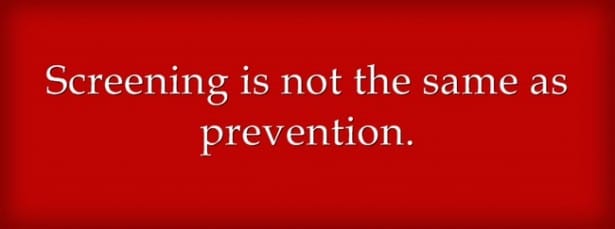Prevention versus screening
- 4 ways your child may not tolerate cow’s dairy: allergy, milk protein sensitivity, cerebral folate deficiency, and lactose intolerance - January 3, 2024
- 5-hydroxytryptophan (5-HTP) and the “feel good” neurotransmitter serotonin - October 4, 2023
- Quercetin supplementation for children: research, safety and efficacy - May 13, 2023

What is prevention? The standard of care for preventive medicine specialists in conventional medicine is determined by the USPSTF (The US preventive services task force), which is an independent panel of experts in primary care (like internists, pediatricians, gynecologists, etc). The USPSTF determines when screening exams are necessary, which medications to take for prevention, and how to counsel patients.
The USPSTF comes up with guidelines based on a review of the scientific evidence, and publishes them in the form of “recommendation statements”. For example, the USPSTF determines at what age mammograms, physical exams, DEXA scans, blood tests, etc., are necessary. These are called “screening” tests because they are done for virtually every person of the recommended age and gender. The hope is that by screening millions of people, we can catch a few people who might actually have a certain disease (and thereby save lives).
Is this prevention? Screening exams, by definition, find people who actually have disease. A mammogram, for example, shows when a woman actually has breast cancer, it does not show that a woman might develop breast cancer in a few years. And it certainly doesn’t tell people how to prevent a disease from occurring in the first place.
Why is this important? Naturopathic physicians are experts in prevention, not screening (though we do a lot of that too). We want to work with our patients years before they get cancer, to talk about how to prevent it to begin with, not how to treat it when they already have it! We want to work with our patients to figure out the cause of their high blood pressure or high cholesterol, not just give them a drug to lower it.
Naturopathic physicians are the true preventive services task force! (We should get some fancy uniforms or something)








Mely
November 14, 2012 at 1:28 amDear Give Me Some HopeBreast cancer is the seoncd most common type of cancer among American women, with approximately 178,000 new cases reported each year (American Cancer Society, Cancer Facts Figures 2007). It is most common in women over 50. Women whose breast cancer is detected early have more treatment choices and better chances for survival. Screening by mammography (an x-ray of the breast) has been shown to reduce mortality by 20 percent–30 percent among women 40 and older.There are several guidelines addressing mammography screening, some of which differ in their recommendations. The US Preventive Services Task Force (USPSTF) 2007 guidelines recommend screening every 1 to 2 years starting at age 40. The recommendations note that evidence is strongest for women aged 50 to 69, with weaker evidence for women aged 40 to 49 because the incidence of breast cancer is lower among women in this age group. The USPSTF concluded that the evidence is also generalizable to women aged 70 and older (who face a higher absolute risk for breast cancer) if their life expectancy is not compromised by comorbid disease. The USPSTF breast cancer screening guidelines are endorsed by the Veterans Administration (VA) National Center for Health Promotion and Disease Prevention, Office of Patient Care Services. Other organizations’ screening recommendations differ with regard to age and/or frequency parameters. For example, the 2004 American College of Radiology guidelines recommend that asymptomatic women 40 years of age or older should have an annual screening mammogram and, because the age at which women may cease to benefit from screening mammography is not clear, the decision at what age to stop routine mammography screening should be made on an individual basis. The American Cancer Society recommends yearly mammograms starting at age 40 and continuing for as long as a woman is in good health. The American College of Physicians recently issued a clinical practice guideline recommending that the decision to screen women in their 40 s should be individualized. Because of ongoing controversy (and anticipated new guidelines) regarding screening of women age 40 to 49, the Veterans Health Administration (VHA) Mission Critical Measure for breast cancer screening will continue to focus on the age 50 to 69 population. Screening rates for the 40 to 49 age groupand the aggregated measure for the 40 to 69 year old population are Health System Indicators for FY2008.